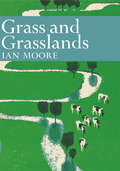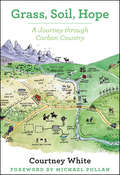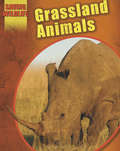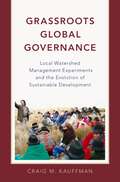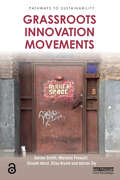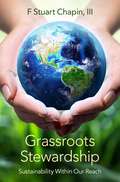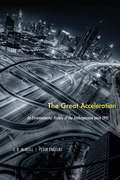- Table View
- List View
Grass and Grassland (Collins New Naturalist Library #48)
by Ian MooreThe use of natural and seeded grass pastures for the feeding of livestock and other unfamiliar uses for the ubiquitous grass family are described in this succinct and beautifully illustrated work.
Grass, Soil, Hope: A Journey Through Carbon Country
by Courtney White Michael PollanThis book tackles an increasingly crucial question: What can we do about the seemingly intractable challenges confronting all of humanity today, including climate change, global hunger, water scarcity, environmental stress, and economic instability? The quick answers are: Build topsoil. Fix creeks. Eat meat from pasture-raised animals. Scientists maintain that a mere 2 percent increase in the carbon content of the planet’s soils could offset 100 percent of all greenhouse gas emissions going into the atmosphere. But how could this be accomplished? What would it cost? Is it even possible? Yes, says author Courtney White, it is not only possible, but essential for the long-term health and sustainability of our environment and our economy. Right now, the only possibility of large-scale removal of greenhouse gases from the atmosphere is through plant photosynthesis and related land-based carbon sequestration activities. These include a range of already existing, low-tech, and proven practices: composting, no-till farming, climate-friendly livestock practices, conserving natural habitat, restoring degraded watersheds and rangelands, increasing biodiversity, and producing local food. In Grass, Soil, Hope, the author shows how all these practical strategies can be bundled together into an economic and ecological whole, with the aim of reducing atmospheric CO2 while producing substantial co-benefits for all living things. Soil is a huge natural sink for carbon dioxide. If we can draw increasing amounts carbon out of the atmosphere and store it safely in the soil then we can significantly address all the multiple challenges that now appear so intractable.
Grasses of Colorado
by Robert B. ShawThis systematic treatment of Colorado grasses will help students, naturalists, botanists, ecologists, agronomists, range scientists, and other interested readers identify and learn about this unique and economically important plant family. Grasses of Colorado describes all grasses known to occur in the state outside of cultivation: more than 300 native, introduced, naturalized, and adventive species. Colorado's elevation range of more than 11,000 feet creates a wide variety of habitats that supports a spectacular diversity of grasses. With 335 known species, Colorado has one of the most diverse and extensive grass floras in the United States. Comprehensive coverage, useful keys, and detailed species descriptions in Grasses of Colorado will make this volume the standard reference for years to come. Robert B. Shaw provides overviews of Colorado's physiography and ecoregions and introduces the grass plant in plain, enjoyable text. He includes a checklist of Colorado grasses, a bibliography, and a glossary of terms that may be unfamiliar to nonspecialists. Line drawings, state distribution maps, and habitat notes for each species enable accurate plant identification, familiarity with regional ecogeography, and increased understanding of plant ecology of the Rocky Mountains. A monumental accomplishment certain to become the standard work on the subject, Grasses of Colorado synthesizes existing literature and incorporates recent scientific findings to offer a complete, current reference.
Grassland Animals (Saving Wildlife)
by Sonya NewlandGrassland Animals looks at the effects of human habitation and hunting on creatures of the world's savannahs and prairies -- from the planet's greatest predators to insects in the grass.It is part of the Saving Wildlife series, which investigates the world's endangered species in the context of their different environments.
Grasslands of the World: Diversity, Management and Conservation
by Victor R. Squires Jürgen Dengler Haiying Feng Limin HuaThis book begins with a brief account of the extraordinary sequence of events that led to emergence of grasslands as major vegetation formations that now occupy some of the driest and hottest and the highest and coldest on earth as well as vast steppes and prairies in more temperate climes. It is the story of grasses successfully competing with forests and woodlands, aided and abetted by grazing herbivores and by humans and their use of fire as a tool. It is a story of adaptation to changing climates and the changing biophysical environments. A major focus of the book is the Palaearctic biogeographic realm that extends over some 45 million km² and thus more than 1/3 of the terrestrial ice-free surface on Earth. It comprises extensive grasslands of different types and origin, which can be subdivided into (1) natural grasslands with (1a) steppes (climatogenic in dry climates), (1b) arctic-alpine grasslands (climatogenic in cold climates) and (1c) azonal and extrazonal grasslands (pedogenic and topogenic) as well as (2) secondary grasslands created and sustained by human activities, such as livestock grazing, mowing or burning. Grasslands of the Palaearctic do not only form a major basis for the agriculture of the region and thus its food supply, but are also crucial for other ecosystem services and host a supra proportional part of the realm’s plant and animal diversity. To reflect that suitability of grasslands for biodiversity strongly depends on their state, we apply the term High Nature Value grassland to those natural grasslands that are not degraded (in good state) and those secondary grasslands that are not intensified (semi-natural). The situation in a variety of countries where grasslands are evolving under the influence of global climate change is also considered. Case studies are presented on Southern Africa, Eastern Africa, India, China, South America, North America and Australia. The concluding chapter examines a set of themes arising from the chapters that make up the bulk of this book. The following provide a focus: recent history of grassland biomes – brief recap of current thinking and recent trends with special reference to dry grasslands in the Palearctic regions; the current status of grasslands and germplasm resources (biodiversity) – an overview; management systems that ensure sustainability; how to recover degraded grasslands; socio-economic issues and considerations in grassland management; the impacts of environmental problems in grasslands such as future climate change and intensification and the problems/prospects facing pastoralists and other grassland-based livestock producers.
Grasslands of the World: Diversity, Management and Conservation
by Victor Roy Squires Haiying Feng Limin Hua Jürgen DenglerThis book begins with a brief account of the extraordinary sequence of events that led to emergence of grasslands as major vegetation formations that now occupy some of the driest and hottest and the highest and coldest on earth as well as vast steppes and prairies in more temperate climes. It is the story of grasses successfully competing with forests and woodlands, aided and abetted by grazing herbivores and by humans and their use of fire as a tool. It is a story of adaptation to changing climates and the changing biophysical environments. A major focus of the book is the Palaearctic biogeographic realm that extends over some 45 million km² and thus more than 1/3 of the terrestrial ice-free surface on Earth. It comprises extensive grasslands of different types and origin, which can be subdivided into (1) natural grasslands with (1a) steppes (climatogenic in dry climates), (1b) arctic-alpine grasslands (climatogenic in cold climates) and (1c) azonal and extrazonal grasslands (pedogenic and topogenic) as well as (2) secondary grasslands created and sustained by human activities, such as livestock grazing, mowing or burning. Grasslands of the Palaearctic do not only form a major basis for the agriculture of the region and thus its food supply, but are also crucial for other ecosystem services and host a supra proportional part of the realm’s plant and animal diversity. To reflect that suitability of grasslands for biodiversity strongly depends on their state, we apply the term High Nature Value grassland to those natural grasslands that are not degraded (in good state) and those secondary grasslands that are not intensified (semi-natural). The situation in a variety of countries where grasslands are evolving under the influence of global climate change is also considered. Case studies are presented on Southern Africa, Eastern Africa, India, China, South America, North America and Australia. The concluding chapter examines a set of themes arising from the chapters that make up the bulk of this book. The following provide a focus: recent history of grassland biomes – brief recap of current thinking and recent trends with special reference to dry grasslands in the Palearctic regions; the current status of grasslands and germplasm resources (biodiversity) – an overview; management systems that ensure sustainability; how to recover degraded grasslands; socio-economic issues and considerations in grassland management; the impacts of environmental problems in grasslands such as future climate change and intensification and the problems/prospects facing pastoralists and other grassland-based livestock producers.
Grasslands on the Third Pole of the World: Structure, Function, Process, and Resilience of Social-Ecological Systems
by Shikui Dong Yong Zhang Hao Shen Shuai Li Yudan XuThis book comprehensively covers the topics of origin and distribution, evolution and types, regional and global importance, biodiversity conservation, plant-soil interfaces, ecosystem functions and services, social-ecological systems, climate change adaptations, land degradation and restoration, grazing management and pastoral production, and sustainable future of the grasslands on the Qinghai-Tibetan Plateau (QTP), which is a globally unique eco-region called the "Roof of the World" because of its high elevation, “Third Pole on Earth" because of its alpine environment and the "Water Tower in Asia" because of its headwater location. The grassland ecosystem covers above 60% of QTP, which is about 2.5 million km2, 1/4 of Chinese total territorial lands.The grassland ecosystem of the QTP (the Third Pole) is an important part of the palaearctic region, which features alpine cover and low oxygen. The Third Pole's grasslands not only provide important ecosystem functions such as biodiversity conservation, carbon storage, water resource regulation, climate control, and natural disaster mitigation at a global scale, but also provide critical ecosystem services such as pastoral production, cultural inheritance, and tourism and recreation at local and regional scales.The purposes of this monograph are to address the following questions: (1) What are the special features of the Third Pole's grasslands? (2) How have climate changes and human activities changed the structures and functions of the Third Pole's grasslands? (3) How can we cope with land degradation and climate change through innovative restoration and protective actions for Third Pole's grasslands? And (4) How can we promote the sustainable development of social-ecological systems of the Third Pole's grasslands through best management practices including grazing. The goal of this book is to attract the attention of international audiences to realize the importance of the Third Pole’s grasslands, and to call for the actions of global communities to effectively protect and sustainably use the Third Pole's grasslands. This book can be served as textbooks, teaching materials and documentaries for different audiences. The target audiences include students, teachers, researchers, policy makers, planners, government officials, and NGOs in agricultural, environmental and natural resources sectors.
Grassroots Approaches to Education for Sustainable Development: A Comparative Study of the USA and India
by Radhika Iyengar Pooja IyengarThis book showcases and compares grassroots environmental education initiatives and actions in Millburn, New Jersey in the USA, and Bhopal, Madhya Pradesh in India. Across the two towns the collective actions discussed include the Fridays For Future strikes, activism through school's 'green team', plastic clean-up missions, conducting workshops, conferences, and organizing green fairs. The authors discuss a range of concepts and ideas that have a broader relevance to local and global environmental education such as global citizenship, climate activism, national and municipal policies, gender, and ecofeminism. They show how the stories of the two towns are connected with sustainable development goals and education for sustainable development. Ultimately the book shows how education can be used as a tool to promote climate change solutions and how this can benefit schools, communities and the planet.The book includes a Foreword written by Ruth DeFries, University Denning Professor of Sustainable Development at Columbia University, USA.
Grassroots Approaches to Education for Sustainable Development: A Comparative Study of the USA and India
by Radhika Iyengar Pooja IyengarThis book showcases and compares grassroots environmental education initiatives and actions in Millburn, New Jersey in the USA, and Bhopal, Madhya Pradesh in India. Across the two towns the collective actions discussed include the Fridays For Future strikes, activism through school's 'green team', plastic clean-up missions, conducting workshops, conferences, and organizing green fairs. The authors discuss a range of concepts and ideas that have a broader relevance to local and global environmental education such as global citizenship, climate activism, national and municipal policies, gender, and ecofeminism. They show how the stories of the two towns are connected with sustainable development goals and education for sustainable development. Ultimately the book shows how education can be used as a tool to promote climate change solutions and how this can benefit schools, communities and the planet.The book includes a Foreword written by Ruth DeFries, University Denning Professor of Sustainable Development at Columbia University, USA.
Grassroots Environmental Governance: Community engagements with industry (Routledge Research in Global Environmental Governance)
by Michael J. Watts Leah S. HorowitzGrassroots movements can pose serious challenges to both governments and corporations. However, grassroots actors possess a variety of motivations, and their visions of development may evolve in complex ways. Meanwhile, their relative powerlessness obliges them to forge an array of shifting alliances and to devise a range of adaptive strategies. Grassroots Environmental Governance presents a compilation of in-depth ethnographic case studies, based on original research. Each of the chapters focuses specifically on grassroots engagements with the agents of various forms of industrial development. The book is geographically diverse, including analyses of groups based in both the global North and South, and represents a range of disciplinary perspectives. This allows the collection to explore themes that cross-cut specific localities and disciplinary boundaries, and thus to generate important theoretical insights into the complexities of grassroots engagements with industry. This volume will be of great interest to scholars of environmental activism, environmental governance, and environmental studies in general.
Grassroots Environmental Governance: Community engagements with industry (Routledge Research in Global Environmental Governance)
by Michael J. Watts Leah S. HorowitzGrassroots movements can pose serious challenges to both governments and corporations. However, grassroots actors possess a variety of motivations, and their visions of development may evolve in complex ways. Meanwhile, their relative powerlessness obliges them to forge an array of shifting alliances and to devise a range of adaptive strategies. Grassroots Environmental Governance presents a compilation of in-depth ethnographic case studies, based on original research. Each of the chapters focuses specifically on grassroots engagements with the agents of various forms of industrial development. The book is geographically diverse, including analyses of groups based in both the global North and South, and represents a range of disciplinary perspectives. This allows the collection to explore themes that cross-cut specific localities and disciplinary boundaries, and thus to generate important theoretical insights into the complexities of grassroots engagements with industry. This volume will be of great interest to scholars of environmental activism, environmental governance, and environmental studies in general.
Grassroots Global Governance: Local Watershed Management Experiments and the Evolution of Sustainable Development
by Craig M. KauffmanWhen international agreements fail to solve global problems like climate change, transnational networks attempt to address them by implementing "global ideas" -- policies and best practices negotiated at the global level-locally around the world. Grassroots Global Governance not only explains why some efforts succeed and others fail, but also why the process of implementing global ideas locally causes these ideas to evolve. Drawing on nodal governance theory, the book shows how transnational actors' success in putting global ideas into practice depends on the framing and network capacity-building strategies they use to activate networks of grassroots actors influential in local social and policy arenas. Grassroots actors neither accept nor reject global ideas as presented by outsiders. Instead, they negotiate whether and how to adapt them to fit local conditions. This contestation produces experimentation, and results in unique institutional applications of global ideas infused with local norms and practices. Grassroots actors ultimately guide this process due to their unique ability to provide the pressure needed to push the process forward. Experiments that endure are perceived as "successful," empowering those actors involved to activate transnational networks to scale up and diffuse innovative local governance models globally. These models carry local norms and practices to the international level where they challenge existing global approaches and stimulate new global governance institutions. By guiding the way global ideas evolve through local experimentation, grassroots actors reshape international actors' thinking, discourse, organizing, and the strategies they pursue globally. This makes them grassroots global governors. To demonstrate this, the book compares transnational efforts to implement local Integrated Watershed Management programs across Ecuador and shows how local experiments altered the global debate regarding sustainable development and stimulated a new global movement dedicated to changing the way sustainable development is practiced. In doing so, the book reveals the grassroots level as not merely the object of global governance, but rather a terrain where global governance is constructed.
Grassroots Global Governance: Local Watershed Management Experiments and the Evolution of Sustainable Development
by Craig M. KauffmanWhen international agreements fail to solve global problems like climate change, transnational networks attempt to address them by implementing "global ideas" -- policies and best practices negotiated at the global level-locally around the world. Grassroots Global Governance not only explains why some efforts succeed and others fail, but also why the process of implementing global ideas locally causes these ideas to evolve. Drawing on nodal governance theory, the book shows how transnational actors' success in putting global ideas into practice depends on the framing and network capacity-building strategies they use to activate networks of grassroots actors influential in local social and policy arenas. Grassroots actors neither accept nor reject global ideas as presented by outsiders. Instead, they negotiate whether and how to adapt them to fit local conditions. This contestation produces experimentation, and results in unique institutional applications of global ideas infused with local norms and practices. Grassroots actors ultimately guide this process due to their unique ability to provide the pressure needed to push the process forward. Experiments that endure are perceived as "successful," empowering those actors involved to activate transnational networks to scale up and diffuse innovative local governance models globally. These models carry local norms and practices to the international level where they challenge existing global approaches and stimulate new global governance institutions. By guiding the way global ideas evolve through local experimentation, grassroots actors reshape international actors' thinking, discourse, organizing, and the strategies they pursue globally. This makes them grassroots global governors. To demonstrate this, the book compares transnational efforts to implement local Integrated Watershed Management programs across Ecuador and shows how local experiments altered the global debate regarding sustainable development and stimulated a new global movement dedicated to changing the way sustainable development is practiced. In doing so, the book reveals the grassroots level as not merely the object of global governance, but rather a terrain where global governance is constructed.
Grassroots Innovation Movements (Pathways to Sustainability)
by Adrian Smith Mariano Fressoli Dinesh Abrol Elisa Arond Adrian ElyInnovation is increasingly invoked by policy elites and business leaders as vital for tackling global challenges like sustainable development. Often overlooked, however, is the fact that networks of community groups, activists, and researchers have been innovating grassroots solutions for social justice and environmental sustainability for decades. Unencumbered by disciplinary boundaries, policy silos, or institutional logics, these ‘grassroots innovation movements’ identify issues and questions neglected by formal science, technology and innovation organizations. Grassroots solutions arise in unconventional settings through unusual combinations of people, ideas and tools. This book examines six diverse grassroots innovation movements in India, South America and Europe, situating them in their particular dynamic historical contexts. Analysis explains why each movement frames innovation and development differently, resulting in a variety of strategies. The book explores the spaces where each of these movements have grown, or attempted to do so. It critically examines the pathways they have developed for grassroots innovation and the challenges and limitations confronting their approaches. With mounting pressure for social justice in an increasingly unequal world, policy makers are exploring how to foster more inclusive innovation. In this context grassroots experiences take on added significance. This book provides timely and relevant ideas, analysis and recommendations for activists, policy-makers, students and scholars interested in encounters between innovation, development and social movements.
Grassroots Innovation Movements (Pathways to Sustainability)
by Adrian Smith Mariano Fressoli Dinesh Abrol Elisa Arond Adrian ElyInnovation is increasingly invoked by policy elites and business leaders as vital for tackling global challenges like sustainable development. Often overlooked, however, is the fact that networks of community groups, activists, and researchers have been innovating grassroots solutions for social justice and environmental sustainability for decades. Unencumbered by disciplinary boundaries, policy silos, or institutional logics, these ‘grassroots innovation movements’ identify issues and questions neglected by formal science, technology and innovation organizations. Grassroots solutions arise in unconventional settings through unusual combinations of people, ideas and tools. This book examines six diverse grassroots innovation movements in India, South America and Europe, situating them in their particular dynamic historical contexts. Analysis explains why each movement frames innovation and development differently, resulting in a variety of strategies. The book explores the spaces where each of these movements have grown, or attempted to do so. It critically examines the pathways they have developed for grassroots innovation and the challenges and limitations confronting their approaches. With mounting pressure for social justice in an increasingly unequal world, policy makers are exploring how to foster more inclusive innovation. In this context grassroots experiences take on added significance. This book provides timely and relevant ideas, analysis and recommendations for activists, policy-makers, students and scholars interested in encounters between innovation, development and social movements.
Grassroots Stewardship: Sustainability Within Our Reach
by F Stuart ChapinIn a society more concerned with how to cope with existential dread than how to make actionable changes to save the planet, a surprisingly large number of Americans identify as environmentalists. What can individual people do to lessen human impacts on the planet? This is not an easy question. Most research is focused on large-scale changes that go beyond anything an individual can accomplish, and people are left feeling defeated rather than inspired to make changes in their everyday lives. Change starts at home, and F Stuart Chapin, III has assembled a book for people who want to learn more about global changes and, more importantly, what they can do about them, starting today. Grassroots Stewardship approaches our current situation with an educated sense of hope and positivity. This book emphasizes actions by individuals, rather than governmental or corporate institutions, to trigger transformational change. Readers will learn what they can do to most significantly transform their communities and the planet with more sustainable pathways.
Grassroots Stewardship: Sustainability Within Our Reach
by F Stuart ChapinIn a society more concerned with how to cope with existential dread than how to make actionable changes to save the planet, a surprisingly large number of Americans identify as environmentalists. What can individual people do to lessen human impacts on the planet? This is not an easy question. Most research is focused on large-scale changes that go beyond anything an individual can accomplish, and people are left feeling defeated rather than inspired to make changes in their everyday lives. Change starts at home, and F Stuart Chapin, III has assembled a book for people who want to learn more about global changes and, more importantly, what they can do about them, starting today. Grassroots Stewardship approaches our current situation with an educated sense of hope and positivity. This book emphasizes actions by individuals, rather than governmental or corporate institutions, to trigger transformational change. Readers will learn what they can do to most significantly transform their communities and the planet with more sustainable pathways.
Grassroots to Global: Broader Impacts of Civic Ecology
by David MaddoxAddressing participatory, transdisciplinary approaches to local stewardship of the environment, Grassroots to Global features scholars and stewards exploring the broad impacts of civic engagement with the environment.Chapters focus on questions that include: How might faith-based institutions in Chicago expand the work of church-community gardens? How do volunteer "nature cleaners" in Tehran attempt to change Iranian social norms? How does an international community in Baltimore engage local people in nature restoration while fostering social equity? How does a child in an impoverished coal mining region become a local and national leader in abandoned mine restoration? And can a loose coalition that transforms blighted areas in Indian cities into pocket parks become a social movement? From the findings of the authors’ diverse case studies, editor Marianne Krasny provides a way to help readers understand the greater implications of civic ecology practices through the lens of multiple disciplines.Contributors:Aniruddha Abhyankar, Martha Chaves, Louise Chawla, Dennis Chestnut, Nancy Chikaraishi, Zahra Golshani, Lance Gunderson, Keith E. Hedges, Robert E. Hughes, Rebecca Jordan, Karim-Aly Kassam, Laurel Kearns, Marianne E. Krasny, Veronica Kyle, David Maddox, Mila Kellen Marshall, Elizabeth Whiting Pierce, Rosalba Lopez Ramirez, Michael Sarbanes, Philip Silva, Traci Sooter, Erika S. Svendsen, Keith G. Tidball, Arjen E. J. Wals, Rebecca Salminen Witt, Jill Wrigley
Gravel Bed Rivers: Processes, Tools, Environments
by Michael Church Pascale M. Biron André G. RoyGravel-Bed Rivers: Processes, Tools, Environments presents a definitive review of current knowledge of gravel-bed rivers, derived from the 7th International Gravel-bed Rivers Workshop, the 5-yearly meeting of the world’s leading authorities in the field. Each chapter in the book has been specifically commissioned to represent areas in which recent progress has been made in the field. The topics covered also represent a coherent progression through the principal areas of the subject (hydraulics; sediment transport; river morphology; tools and methods; applications of science). Definitive review of the current knowledge of gravel-bed rivers Coverage of both fundamental and applied topics Edited by leading academics with contributions from key researchers Thoroughly edited for quality and consistency to provide coherent and logical progression through the principal areas of the subject.
Gravel Bed Rivers: Processes, Tools, Environments
by Michael Church Pascale Biron Andre RoyGravel-Bed Rivers: Processes, Tools, Environments presents a definitive review of current knowledge of gravel-bed rivers, derived from the 7th International Gravel-bed Rivers Workshop, the 5-yearly meeting of the world’s leading authorities in the field. Each chapter in the book has been specifically commissioned to represent areas in which recent progress has been made in the field. The topics covered also represent a coherent progression through the principal areas of the subject (hydraulics; sediment transport; river morphology; tools and methods; applications of science). Definitive review of the current knowledge of gravel-bed rivers Coverage of both fundamental and applied topics Edited by leading academics with contributions from key researchers Thoroughly edited for quality and consistency to provide coherent and logical progression through the principal areas of the subject.
Grave's End: the brilliant third book in the DS Alexandra Cupidi investigations (DS Alexandra Cupidi)
by William Shaw'If you're not a fan yet, why not?' VAL MCDERMID'A superb storyteller' PETER MAYA BIZARRE DISCOVERYAn unidentified cadaver is found in a freezer in an unoccupied luxury house. No-one seems to know or care who it is or who placed it there. When DS Alexandra Cupidi is handed the case, she can have no idea it will lead her to a series of murderous cover-ups and buried secrets. Namely the discovery of the skeleton of public-school boy, Trevor Wood, beneath a housing development.A HISTORIC CRIMEHis disappearance twenty five years earlier had almost passed unnoticed. But as evidence surfaces that his fate was linked to long suppressed rumours of sexual abuse, Cupidi, her teenage daughter Zoe and her friend Bill South find themselves up against powerful forces who will try to silence them. A BURIED LIFEDigging deep into the secrets that are held underground leads to Cupidi's realisation that crime and power are seldom far apart. There are dangerous connections between the two cases, which are complicated by Constable Jill Ferriter's dating habits, a secret liaison and the underground life of Trevor Grey's only friend.The most riveting and atmospheric DS Alexandra Cupidi novel so far, Grave's End confronts the crisis in housing, environmental politics, the protection given to badgers by the law. With meticulously mastered characters and a brooding setting, this third book in the series confirms William Shaw as one of the finest crime writers.
Grazing and Conservation Management (Conservation Biology #11)
by Michiel F. WallisDeVries, Sipke E. Wieren and Jan P. BakkerGrazing animals enjoy an ambiguous reputation in the field of nature conservation. Livestock are often treated as a scourge, yet native large herbivores form the prime attraction of many a reserve. This book gives the first comprehensive overview of the use of grazing as a tool in conservation management. Considering in turn the ecological and historical background, the impact of grazing on community structure, management applications and future prospects, this book examines issues such as the role of herbivores as keystone species, the assessment of habitat quality and the function of scientific models in advancing grazing management. Large herbivores are shown to be potentially powerful allies in the management of nature reserves, particularly in the maintenance, enhancement or restoration of biodiversity. Grazing and Conservation Management will appeal to conservation biologists and rangeland managers, providing them with a clearer understanding of grazing and conservation management.
Greasy Rider: Two Dudes, One Fry-Oil-Powered Car, and a Cross-Country Search for a Greener Future
by Greg MelvilleIs it possible to drive coast-to-coast without stopping at a single gas pump? Journalist Greg Melville is determined to try. With his college buddy Iggy riding shotgun, this green-thinking guy—who's in love with the idea of free fuel—sets out on an enlightening road trip. The quest: to be the first people to drive cross-country in a french-fry car. Will they make it from Vermont to California in a beat-up 1985 Mercedes diesel station wagon powered on vegetable oil collected from restaurant grease Dumpsters along the way? More important, can two guys survive 192 consecutive hours together? Their expedition on and off the road includes visits to the solar-powered Google headquarters; the National Ethanol Council; the wind turbines of southwestern Minnesota; the National Renewable Energy Lab; a visit to one of the first houses to receive platinum certification for leadership in Energy and Environmental Design (LEED); an "eco-friendly" Wal-Mart; and the world's largest geothermal heating system. Part adventure and part investigation of what we're doing (or not doing) to preserve the planet, Greasy Rider is upbeat, funny, and full of surprising information about sustainable measures that are within our reach.
The Great Acceleration: An Environmental History Of The Anthropocene Since 1945
by J. R. McNeillThe pace of energy use, greenhouse gas emissions, and population growth has thrust the planet into a new age—the Anthropocene. Humans have altered the planet’s biogeochemical systems without consciously managing them. The Great Acceleration explains the causes, consequences, and uncertainties of this massive uncontrolled experiment.
The Great Acceleration: An Environmental History Of The Anthropocene Since 1945
by J. R. McNeillThe pace of energy use, greenhouse gas emissions, and population growth has thrust the planet into a new age—the Anthropocene. Humans have altered the planet’s biogeochemical systems without consciously managing them. The Great Acceleration explains the causes, consequences, and uncertainties of this massive uncontrolled experiment.
